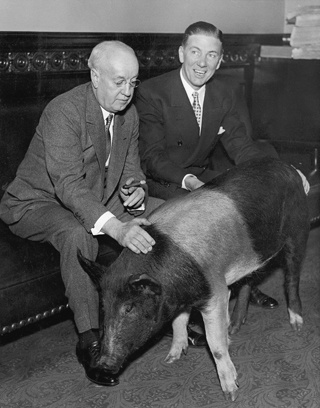The Iowa Hawkeyes will host the Minnesota Golden Gophers on Nov. 14, marking the 80th anniversary of the first game the two schools fought over the now-legendary pig, Floyd of Rosedale.
Sandy Boyd remembers the day.
“I was 8 years old, and my father and I took the streetcar down to the Minnesota state capitol, where they were having a small ceremony,” says Boyd, a now 88-year old retired UI law professor and president emeritus. “The governors of Iowa and Minnesota were there and so was Floyd.”
This was Nov. 13, 1935, just a few days after the two governors each bet a prize hog on the outcome of the Gopher–Hawkeye football game in an effort to quell the potential of racially motivated violence between the two teams. Minnesota won the game 13–6, so Iowa Gov. Clyde Herring came north to pay his debt to Minnesota Gov. Floyd B. Olson, whom the pig would be named after.

Boyd’s family had something of a vested interested in Floyd—and in more ways than one. Boyd's father, Willard L. Boyd Sr. was a renowned member of Minnesota’s veterinary school faculty (Boyd Avenue in St. Paul is named after him), so prominent pigs were always of interest. Willard Sr. also served as a faculty representative to the university’s board in control of athletics from 1914 to 1951, so Boyd said his family bled maroon and gold.
“We were rabid Gopher fans,” he says. “This was when they had a great football team and won national championships. It’s when they became known as The Golden Gophers.”
At the state capitol ceremony, a few words were spoken and jokes cracked, and Herring handed Floyd over to Olson to make good on the wager. He was a Hampshire boar, black with a white belt, bred at Rosedale Farms in Webster County. And he wasn’t just any pig. Floyd was the progeny of a four-time grand champion, and his brother, Blue Boy, had appeared in the 1933 movie State Fair.
But Boyd doesn’t remember much about Floyd’s details.
“He was a big pig, that’s all I could tell,” he says with a shrug.
Following the ceremony, Olson gave Floyd to the university, and he was brought to a temporary home on the ag. school campus in St. Paul, adjacent to the state fairgrounds. Boyd saw Floyd frequently for a time after that, when he walked through campus and past the hog pens, but he admits that he was never sure which pig was Floyd. He was pretty indistinguishable from the others. It’s not like he wore a sash that said “Floyd of Rosedale.”
“They didn’t have him in a separate area or set apart in any way,” Boyd says. “He was in a big pen with the rest of the hogs, and he blended in pretty well.”
Floyd was on campus for the next few weeks or months—Boyd can’t remember now how long for sure—until one day he noticed the pens were empty.
“They didn’t say when he was going or where he went,” Boyd says. “He was just gone.”
Sadly, neither of the two Floyds survived to see the 1936 Gopher–Hawkeye game. Olson, it turned out, was already suffering from stomach cancer when he took possession of his porcine namesake and died Aug. 22, 1936, at age 44. Floyd the pig would not even make it that long. He eventually wound up on a hog farm in southeastern Minnesota, just six miles from the Iowa border, then promptly died of cholera in July 1936.
Boyd, meanwhile, continued to bleed maroon and gold until he joined the Iowa law faculty in 1954. “Then I switched my allegiance and I’ve been bleeding black and gold ever since,” he says.
